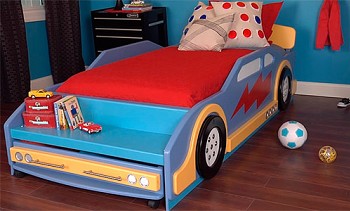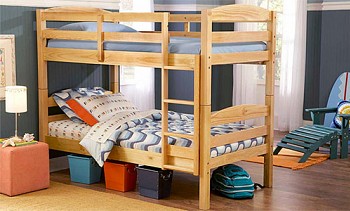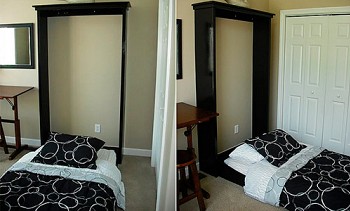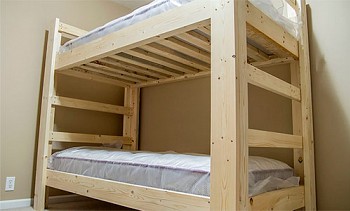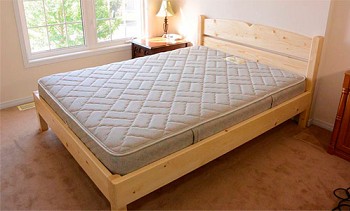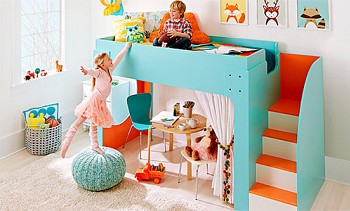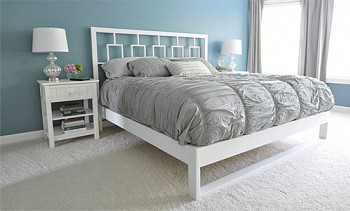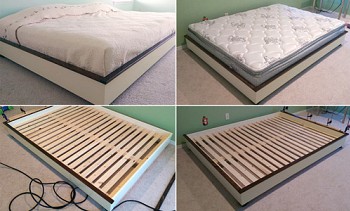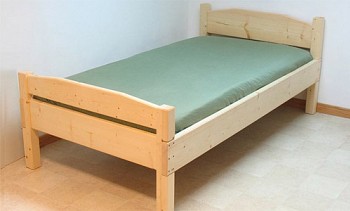The soft headboards of the rhombic-patterned beds look amazing, but they are too expensive, so I was not sure that someday I could afford such a luxury. Years later, when a lot of experience accumulated over my shoulders in various furniture projects, I myself made the headboard, which I dreamed about for a long time, and I will teach you this with great pleasure! From my detailed instructions you will learn how to make a soft headboard with your own hands, and in the simplest and cheapest way possible!
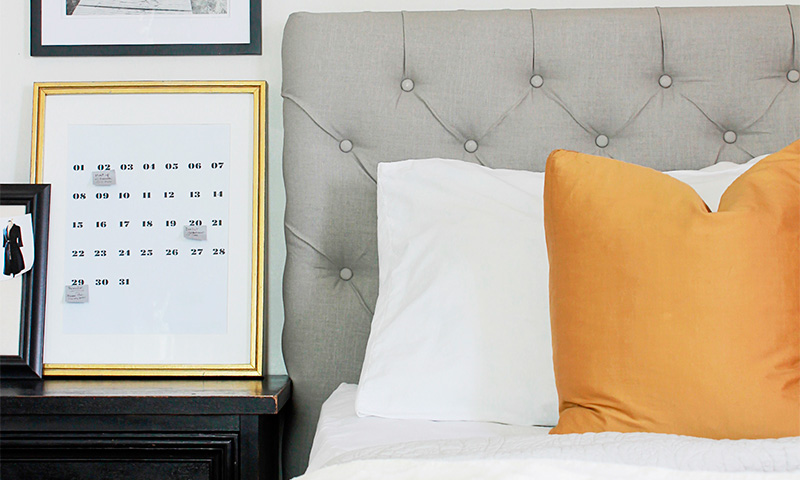
Content:
Materials:
- The frame of the old headboard and wooden panels (possibly from old disassembled furniture);
- Cellular foam mattress cover (1 m wide, even for a king size bed);
- The cloth;
- A set of buttons to be fitted (I needed 37 of these buttons);
- Ordinary buttons;
- Upholstery twine / hemp rope / waxed thread for sewing buttons;
- Glue (I used super-strong Gorilla glue glue).
Headboard frame preparation
Do you have a lost headboard? Fine! Of course, you can buy lumber and make a new frame, but why not use what you already have.
The headboard of my bed, inherited from my grandparents, was uncomfortable and looked unpresentable. And when one night I was flooded by the neighbors living a floor above, as a result of which all the furniture was badly damaged, I finally decided to part with it. I removed the ugly plastic panels from the front of the headboard to get to the skeleton.
After that, I started looking for any waste wood of the right size. For example, I had two MDF doors from an old broken wardrobe, which I cut out in length and nailed to the frame. It is not worth striving for any special beauty at this stage, just nail or screw the boards to the frame with screws.
The frame of the headboard was slightly lower than I wanted, and I built it up with the help of 5x5 cm bars. Special strength is not required here, it is not even necessary to fasten these bars to the existing frame. Just nail or glue them to the front panels. The bars extending to the frame serve only to hold the brackets securing the fabric.
On the back side, the structure looks like trash, the place of which is in a landfill. Haha What can I say? I like to use everything that comes to hand in work. For example, I used door hinges from the same cabinet as the doors to fasten the panels. Perfection is not required when it comes to the frame.
Cloth Holes
The time has come to put a marking on which you will drill holes for the subsequent fastening of the fabric. I hate taking any measurements, so I did a quick search on Pinterest for “DIY tufted headboards” and found that some craftsmen use the punched Pegboard as a base for headboards, often used for organized storage of tools and other items. A good idea! True, a perforated plate of this size will cost a lot, and it does not have sufficient strength. With this in mind, I decided to use the Pegboard only as a template to mark the holes at the head of my bed.
What should be done:
1. Measure the head and mark its center.
2. Center the fragment of the perforated plate you have in the center of the headboard.
3. Start at the marked center, but three holes below.
4. Use a marker to transfer the holes to the wooden base. You can circle the holes already transferred on the perforated plate, so as not to forget what has already been done.
5. Mark the point (without forgetting to circle the hole), then skip the seven holes, and put the point again in the eighth. Continue to follow this pattern.
6. The second row should be offset relative to the first by three positions, i.e. the new point will be opposite the fourth hole. As a result, you will get the shape of a rhombus (see photo below).
7. When you reach the edges of your perforated panel, simply move it, aligning the already drawn points with the corresponding holes. Continue until the entire upper half of the head is covered with dots in geometric order. There is no need to lay out the entire headboard - only to the level of placement of the mattress.
After you have finished marking the surface of the head, make sure that you do not miss a single point. If you outlined the holes on the panel, it will be much easier to do! There is nothing worse than removing the perforated plate, and then discover that not all the points are set.
TIP: Do not put dots to the very edges of the head, leave a few centimeters intact.
Now it’s time to drill holes at all the marked points! The holes do not have to be very large, enough for the needle to pass freely through them. Shake off the sawdust.
If access to any holes on the back of the structure is blocked by frame elements, drill through the bars so that nothing prevents you from covering the back.
Fixing foam rubber and fabric
Take two pieces of packing foam rubber of a suitable size (it will be much cheaper than buying furniture upholstery foam rubber) and place it on the front surface of the headboard with the honeycomb side down. Align the top and sides of the foam with the edges of the wooden back, cutting off any excess. Secure the bottom and sides (top not necessary) with a furniture stapler.
Drape the design with a piece of fabric. Measuring the material, make a margin of 25-30 cm from all sides.
Lift the fabric-covered head upright and lean against the wall. At the same time, keep in mind that when the time comes to cover the back, you will have to have free access to its front and back sides. It’s good if you have an assistant who will hold the back.
Button Cover
The time has come to put the buttons on the fabric. This is the hardest part of the project. I hate this job! Maybe this is because I bought the cheapest kit, I don’t know, but my fingers hurt very much when I made only 7 buttons. You must follow the instructions on the packaging with the blanks, but as soon as you read it, come back here. I will give you some good tips that will greatly facilitate the process. Yes, and do not forget to use a good glue if you do not want the button caps to fall off over time.
Button Tips:
- Not all kits are the same. I bought two sets of the same brand, but it turned out that the rubber mold fit well with buttons from one set and much worse from the other. In any case, one set is not enough for you, just try all the rubber molds until you find the one that you like best.
- Cut fabric with a small margin, i.e. A little more than the template that comes with the kit. It is better to cut off the excess material after you have pushed the button cover into the rubber mold than painfully trying to center a small patch.
- Insert the fabric and button cover into the rubber mold on one side, then slowly insert them all the way. Otherwise, you will not succeed.
- If you do not want to ever repeat all this again before you insert the button leg, grease its edges with a small amount of glue.Remember that if you add too much glue, its excess will be on the outside (if this still happened, blot the glue with a napkin). Allow the glue to dry overnight before using the finished buttons.
- Pulling the “pusher” into place is very difficult! He slips out, you have to finger him all the time ... pah! My super smart advice to you (this knowledge came to me only with experience): use a wooden hammer so as not to pinch your fingers, trying to hammer the "pusher" into place! My poor blue finger ...
Headboard trim
You will need a long needle with a large eye, regular buttons and upholstery twine. The knots on this smooth twine are easily untied, but on the other hand, it freely passes through the foam and fabric. Just make sure that you have tied the knot in a good quality (and more than once) so that it does not relax over time.
Insert a long piece of twine into the needle and then put a button on it. Do you want the button not to slip? Then pass the twine through all 4 holes (as if you were sewing on this button) and tie some knots.
Pass the needle through the drilled hole, moving from the back of the back to the front. Start work from the top center hole. Be sure to keep the needle straight.
Fasten the decorative button on the front of the headboard.
How to fix the button on the front side of the head:
1. Pass the needle through the eye of a fitted button.
2. Make one revolution of the thread around the button and thread it through the eye again.
3. Drown the button in foam while pulling the thread. The buttonhole will have to hold the button in this position, unless, of course, an effort is made to tighten it.
4. Cut the twine leaving small tails.
5. Tie the ends of the twine at the bottom of the button (as if you were tying shoelaces).
6. Tie another knot on the other side of the button. Repeat the operation several times.
7. Cut off the extra length of the twine, lay the short ponytails under the button.
8. Pinch the fabric, forming folds on it.
To illustrate how this happens - watch animation (the size of the animation is about 8 mb, so before it appears you need to wait a bit).
Before moving on to the second row, read the next section, which has some information you should know about the first line. The only thing I messed up was the first row, so, unfortunately, the head of my bed is not perfect, but you have a chance!
The important point regarding the first row
At some point in my work, I began to realize that I had not taken one important small step in the beginning. A disappointing excuse for this is the fact that I did not have the opportunity to learn from the mistakes of others. Make sure that you do not forget to take this step, and then every rhombus on your back will be perfect.
Immediately after you fasten the first button, stop and make a crease going up. Now fasten the next button and fold again ...
After you “sewn” the first 3 or 4 buttons, pull the fabric on the back and fix the folds with furniture staples. Make sure all folds are facing one way. Fasten the remaining buttons (and folds) in the first row in the same way.
When you have made the first row, you can move on, stitching the entire remaining surface of the head. Now you have to do micro-folds with your fingers after adding each new button to get perfect rhombuses.
Fabric fastening
After you have completely flashed your headboard, it is time to fasten the fabric around the edges. Lay the headboard on the floor, face down. You have already fixed the fabric at the top of the head of the head, but that doesn’t stop adding a few extra staples.To get accurate corners, bend by pulling the top side down and then closing it with a taut sidewall, then secure the fold with brackets. Continue fastening the sides, remembering to tighten the fabric. The front should look perfect, and the rear view is not so important.
Before fixing the lower edge of the fabric, rest the headboard vertically and cut off excess fabric around the legs. There is no need to fix the fabric from the front of the leg; it is tightly stretched at the back.
The back side of the headboard
Now, if you wish, you can slightly embellish the back side of the head of the bed. For this purpose I used an old, but still strong sheet and several upholstery cloves. I drove the cloves quite far apart, so that if necessary, I can easily remove the backdrop.
TIP: If one of your decorative buttons relaxes over time (or you initially pulled it not well enough), pull the cord with the button located on the back of the back and fasten it with a bracket just below. Now everything is tight, there is no need to redo the work.
The do-it-yourself process of making a soft headboard has come to an end. You can enjoy looking at this magnificent work of art!
I hope you enjoyed your headboard (I like mine very much). Now make your bed even prettier with the right bedding!

























